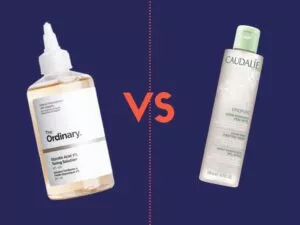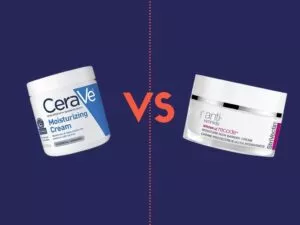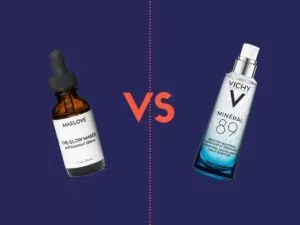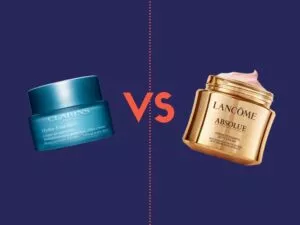Comparing High-end and Budget-friendly Skincare

High-end vs drugstore skincare: Which is worth it?
I remember my first Chanel lipstick: it was in that classic rouge colour. After purchasing it, I felt like a grown-up; an independent, sophisticated woman who after getting her first full-time job could afford that $60 little black package with a golden symbol on the bottom. Since then, my appreciation for fashion houses with long history did not lessen. However, my understanding and ability to test and compare both high-end and budget-friendly skincare and cosmetics expanded.
Opposing opinions about whether a moisturizer should cost more than $100, and whether its anti-ageing components are truly effective, are rising among bloggers, dermatologists, and consumers. While opinions might differ, there is one thing that most people agree on – a balance. At first, you want to fully understand that the largest human organ (your skin!) requires proper care.
Applying sunscreen, and using moisturizer are two basic steps to start with. Both products, to achieve positive results, have to be of decent quality (later on, we will take an in-depth look at ingredients of both luxury and drug-store skincare). Yet, at the same time, when it comes to makeup, you might not need to spend about $30 on a Dior mascara, because, well, L’Oreal does the same job and leaves you with the same result for around $9 only.
When it comes to cosmetics, and for now, we will put aside brand names and the influence of Instagram bloggers, what matters the most is the promised results and cleanliness of ingredients.
Skincare ingredients to avoid/consider:
At first, I want to briefly list a few ingredients that have to be avoided when shopping for skincare. After that, we will observe the list of ingredients that are included in most skincare products, despite the price point. The reason vegan, green cosmetic market is expanding is based on consumers’ understanding that harmful elements affect not only their health but also the environment. Thus, chasing young-looking skin and overall beauty, pay attention to the ingredients list and make sure it excludes aluminum, DEA, MEA, TEA, mineral oil, parabens, phthalates and propylene glycol, and fragrances. Certainly, there are more ingredients on the list, yet those are most commonly used. The reason you want to make sure your skincare does not include those components is that skin absorbs up to 60% of all products we put on it. We use a tremendous number of skincare products every single day, and it is no wonder that can affect our overall wellbeing and skin condition. According to many latest pieces of research, those ingredients also can cause allergies, eczema, cancer and many other health issues.
Now, to the ingredients that make a base for the majority of skincare and makeup merchandise. Anti-ageing skincare includes such elements as retinol, vitamin C, water, glycolic acid, sunscreen and ceramides. Most of the time, even though ingredients are the same in both luxury and budget-friendly moisturizers, one comes from a natural source and the other one was sourced at a laboratory. That factor also affects the price. Besides that, luxury brands often include rare ingredients that also increase the price. However, the question is, do those ingredients work? For example, Stephen Alan Ko, cosmetic formulator says that “Green tea extract is a relatively common ingredient, but the purity of the ingredient can change the cost of the raw material by many magnitudes.” For that reason, plus marketing, plus package, and the brand’s name, one of La Mer creams costs nearly $320, as they confirm the sea kelp it uses are rare and sustainably sourced.
While it might be true about moisturizers — and when that ingredient penetrates through skin it may feel like a miracle –, it is not as simple with makeup products. For example, ingredients that most lipsticks are made of are wax, oil and pigment. After that, ingredients vary and can have either bee wax, animal products, vitamin E and other components. As long as a lipstick includes no heavy metals and fragrances that could be harmful, the price point relies on the brand name solely. With that in mind, there is not a big difference between drug-store lipsticks and luxury brands; thus, paying $50 for YSL tint or $7 for L’Oreal makes a big difference in price, design, brand name but not ingredients.
Comparing actual skincare products:
The Ordinary Glycolic Toning Solution ($8.70) vs. Caudalie ($34.00)
One of the main differences between The Ordinary and Caudalie is that the latter includes a complex of essential oils formulated with carrier oils. I found it much smoother than The Ordinary product on those parts of my face that needed a delicate product that would not overdry them. However, as I have combination skin, The Ordinary toning solution helped with reducing extra oil excretions. Another factor I have noticed about Caudalie is how gentle and lightweight it felt on my skin. Meanwhile, The Ordinary tonner was fighting acne better. Thus, to draw a line between those two products, I would rely on the type of skin and particular needs. However, results after using both of them were fairly similar.

CeraVe ($25.99) vs. StriVectin ($119.00)
StriVectin is one of my favourite skincare brands, yet I find that unless you buy a whole set or track deals, the price might get a bit steep when you consider that a one average size face needs a moisturizer, a day cream, a night cream, an under-eye cream, etc. Therefore, I have decided to see what was the hype around a much cheaper, yet well-advertised CeraVe moisturizer. To compare ingredients, StriVectin’s ultimate daytime moisturizer includes ceramides, plant-derived cholesterol and free fatty acids. When I compared the list of ingredients in both moisturizes, the result was almost identical. CeraVe is also equipped with ceramides. However, the only difference was that StriVectin cream included calendula flower extract and a variety of oils. Now, when I tried both creams on my face, the main difference I have noticed was the texture. CeraVe felt much thicker and heavier than StriVectin. Nonetheless, the final effect after using both creams left my skin well-moisturized, visibly smoother and with no irritation.

Maelove Serum ($27.95) vs. Vichy Hyaluronic Serum ($51.95)
While the price tag does not make a huge difference in this category, I have decided to try Maelove, a new-to-me vegan brand. Although I have been using the Vichy Hyaluronic serum for years and been satisfied with the results, the Maelove serum also surprised me. My skin felt fresh, glowing and had even colour. It is enriched with vitamin C, E, ferulic acid and hyaluronic acid (the ingredient that makes Vichy serum so popular). Besides that, what attracted me was the fact that the brand stands for cruelty-free and vegan beauty.

Clarins ($49.00) vs. Lancome ($270.00)
Another two moisturizers I have compared over time. While Clarins has some exclusive skincare that comes at a price higher than $100, I tested their essential silky cream for normal skin and compared it to Lancome regenerating soft cream. As for the list of ingredients, both creams have very similar components, yet the Lancome moisturizer contains more oils. Perhaps that was the reason why I have noticed such a drastic contrast in texture. While both moisturizers felt comparably light, the Lancome one was almost weightless and penetrated through my skin faster than Clarins. As for results, I would not say I have noticed a tremendous difference. Both creams left my skin well moisturized, and none caused any irritation.

According to my comparisons, and research on well-known cosmetic brands, it is still hard to say whether the precise value of a face cream or a mascara can be determined by the price tag only. There are a few factors that play a significant role to me when it comes to choosing between cheaper and higher-priced skincare.
The first one, as I did with described products, I compare ingredients. As the experiment showed, both moisturizers for $30 and $230 contain similar elements. Then, I turn to the second and third factors, such as the philosophy of the brand and the cleanliness of the product. At some point, I found out about that cruelty–free little rabbit symbol (officially known as the Leaping Bunny Logo), and avoiding parabens, aluminum and other harmful ingredients became more important to me than an attractive package and a prestigious brand.
To bring it to a conclusion, I can affirm that, yes: in order to find the right product, you can shop in both luxury and budget-friendly categories. Consumers can also easily save money on skincare by buying cosmetics at drug stores only. However, it’s essential to always take the long term into consideration, not only short-term savings. After all, the whole ritual of skincare should be seen as an investment into a healthy future.